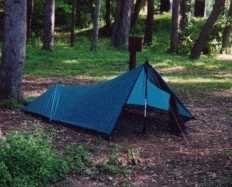|
Henry Shires Tarptent™
3 season, lightweight, hybrid backpacking shelter (Available in One and Two Man versions). Weight: 18 oz. (1 man) 28 oz. (2 man) Dimensions 78" x 93" x 42" (1 man) 80" x 93" x 45" (2 man) Price: $195.00 (1 man) $195.00 (2 man) (or about $100.00 in materials)
|

Made from parachute quality silcone impregnated nylon (sil-nylon), the Tarptent body is fringed at the sides and enclosed front back with no-seeum guage nylon bug screening.
The "envelope" is entered via velcro fastners securing two pieces of screening in the front.
Completely impermiable, all Tarptent models tip the scale safely under the magic 2 lbs. mark (net of hardware)
The addition of an optional Velcro™ in Tyvek™ floor adds improved bug and moisture resistance with a moderate weight cost.
History of the Tarptent
The designer, Henry Shire, developed the Tarptent to meet his own backpacking needs, and after several experimental versions, put the sewing pattern for his initial finished design (Tarptent I) online in 1998.
Based on user feedback and suggestions, Henry made substantial changes to parts of the design in 2001-2002, most importantly the use of a hoop at the foot of the shelter (Tarptent II)(now Squall) and began to focus on the production of finished tents.
Tarptents are now available in several design variants as well as two basic foot prints (1 man or 2 man), as a finished shelter or as a DIY sewing pattern
How It Works
As is typical of lightweight tarp shelters, Tarptents are pitched much as one would pitch an old school pup tent.

In all of Henry's tarptent designs the front is intended to be supported by a hiking pole.
The Tarptent I uses a straight pole in the foot. Unfortunately, the rear of the Tarptent is designed to be pitched slightly too low to accomodate the length of most hiking poles even fully collapsed.
The instructions call for carrying a light custom pole (which is easy enough to fabricate), however jury rigging a compressed pole at any angle will also get the job done in a pinch.
The Tarptent II (Squall) uses a hoop to support the foot, and Henry's finished tarptents include a lightweight pvc batten.
The revised shape greatly improves the Tarptent's water shedding characteristics as well as simplifying set-up.
Other innovations originally suggested by users include a Velcro® in Tyvek® floors and rain deflection panels both of which have been incorporated as options in Henry's finished Tarptents.
Tarptent on the AT
I carried a homebuilt Tarptent I for 1800 of 2200 miles of an Appalachian Trail thru-hike in 2002 (trading it out for a platform capable tarp in the White Mountain Natl forest and Maine).
Although I primarilly slept in fixed shelters in the course of my hike, I managed to pitch the Tarptent in a wide variety of condtions, from a high of 101°F in July to a low of 14°F in November.
I slept the Tarptent on balmy nights, in full on rain and even once in an ice storm at 5000'.
In every case the Tarptent kept me (and all of my gear) dry and as cool and/or warm as can be expected under a tarp on a mountainside.
However, while the bug netting was a nice privacy feature and served as an additional windbreak (and oven door on hot nights) it only did so much to stop the bugs (which, in the east, are fierce). Which is to say that unless perfectly pitched, the Tarptent will keep out moths but won't keep out mosquitoes.
In addition, impermiability is a two-way street, and if, like me, you are a warm sleeper you can often wake up under iminent threat of a rain (and/or ice) storm from your own condensed vapors.
This is, of course, true to a greater or lesser degree of all zero-porosity shelters. However, the problem is much more acute than with traditional tarps which permit open air circulation.
And finally, pitching a tarp is always a piece of 3 dimensional art. The Tarptent I design, however, adds an 4th dimension (and 5th and 6th)
A couple of important disclaimers:
My regular hiking partner, Chris, learned to sew in order to build my tarptent from one of Henry Shire's public domain patterns. He did an amazing job (and on a sewing machine from like 1930). But, it was his first job, and some joinery issues -- particularly at the foot of the tent -- made it difficult to achieve a true bug-tight envelope and certainly added to the difficultly of set up.
I met another long distance hiker (Dave "Lightning Bolt" Brock) in Delaware Water Gap, PA who was carrying a Squall and had carried a homebuilt Tarptent I on a prior PCT thru hike. He indicated that the new design (as well as Henry's workmanship) obviated some of the similar shortcomings (in particular the challenging set up) he had encountered in his first model.
The Final Word
Whatever its shortcomings, I carried my Tarptent for 1800 of 2200 miles in 2002 in preference to several near alternatives.
The Tarptent is best enjoyed on your back. It is extremely light and, more important, insanely packable.
In addition, while I wouldn't necessarilly recommend it for June in southern Maine, it does provides credible 3 season weather protection and is generous enough to accomodate all of your (ultralight) gear.
Finally, while Henry's finished tarptents are certainly a value, there is something to be said for the gruding repspect afforded by stangers -- and typically reserved drifters and armed individuals -- when you pull a homemade tent from your pack.
[Top ^]